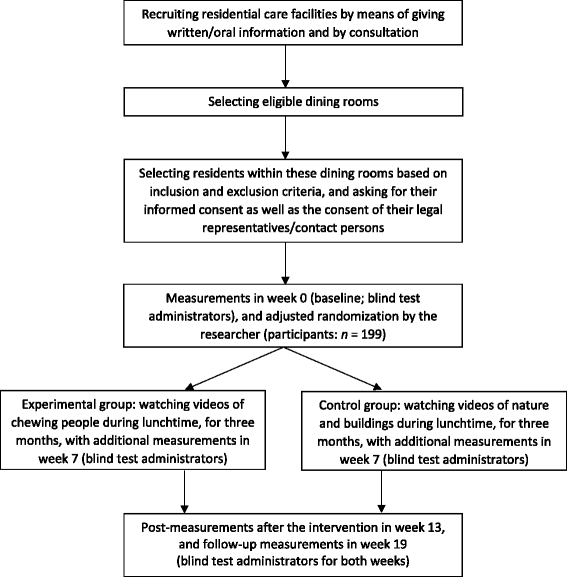The effects of video observation of chewing during lunch on masticatory ability, food intake, cognition, activities of daily living, depression, and quality of life in older adults with dementia: a study protocol of an adjusted randomized controlled trial
- PMID: 26846664
- PMCID: PMC4743084
- DOI: 10.1186/s12877-016-0205-6
The effects of video observation of chewing during lunch on masticatory ability, food intake, cognition, activities of daily living, depression, and quality of life in older adults with dementia: a study protocol of an adjusted randomized controlled trial
Abstract
Background: Masticatory functioning alters with age. However, mastication has been found to be related to, for example, cognitive functioning, food intake, and some aspects of activities of daily living. Since cognitive functioning and activities of daily living show a decline in older adults with dementia, improving masticatory functioning may be of relevance to them. A possible way to improve mastication may be showing videos of people who are chewing. Observing chewing movements may activate the mirror neuron system, which becomes also activated during the execution of that same movement. The primary hypothesis is that the observation of chewing has a beneficial effect on masticatory functioning, or, more specifically, masticatory ability of older adults with dementia. Secondary, the intervention is hypothesized to have beneficial effects on food intake, cognition, activities of daily living, depression, and quality of life.
Methods/design: An adjusted parallel randomized controlled trial is being performed in dining rooms of residential care settings. Older adults with dementia, for whom also additional eligibility criteria apply, are randomly assigned to the experimental (videos of chewing people) or control condition (videos of nature and buildings), by drawing folded pieces of paper. Participants who are able to watch each other's videos are assigned to the same study condition. The intervention takes place during lunchtime, from Monday to Friday, for 3 months. During four moments of measurement, masticatory ability, food intake, cognitive functioning, activities of daily living, depression, and quality of life are assessed. Tests administrators blind to the group allocation administer the tests to participants.
Discussion: The goal of this study is to examine the effects of video observation of chewing on masticatory ability and several secondary outcome measures. In this study, the observation of chewing is added to the execution of the same action (i.e., during eating). Beneficial effects on masticatory ability, and consequently on the other outcome measures are hypothesized. The intervention may be easily integrated into daily care, and might add to the lives of the increasing number of older adults with dementia by beneficially influencing multiple daily life functions.
Trial registration: NTR5124. Registration date: 30 March 2015.
Figures


Similar articles
-
The effects of observation of walking in a living room environment, on physical, cognitive, and quality of life related outcomes in older adults with dementia: a study protocol of a randomized controlled trial.BMC Geriatr. 2015 Mar 18;15:26. doi: 10.1186/s12877-015-0024-1. BMC Geriatr. 2015. PMID: 25886987 Free PMC article. Clinical Trial.
-
Observing videos of mastication in dementia: Results of a clustered randomised controlled trial.J Oral Rehabil. 2024 Mar;51(3):546-555. doi: 10.1111/joor.13618. Epub 2023 Dec 2. J Oral Rehabil. 2024. PMID: 38041598 Clinical Trial.
-
Evaluation of chewing ability and its relationship with activities of daily living, depression, cognitive status and food intake in the community-dwelling elderly.Geriatr Gerontol Int. 2013 Jul;13(3):718-25. doi: 10.1111/ggi.12006. Epub 2012 Dec 21. Geriatr Gerontol Int. 2013. PMID: 23279752
-
Improving food intake in persons living with dementia.Ann N Y Acad Sci. 2016 Mar;1367(1):3-11. doi: 10.1111/nyas.12997. Epub 2016 Jan 15. Ann N Y Acad Sci. 2016. PMID: 26773443 Review.
-
Chewing Maintains Hippocampus-Dependent Cognitive Function.Int J Med Sci. 2015 Jun 9;12(6):502-9. doi: 10.7150/ijms.11911. eCollection 2015. Int J Med Sci. 2015. PMID: 26078711 Free PMC article. Review.
Cited by
-
Environmental and behavioural modifications for improving food and fluid intake in people with dementia.Cochrane Database Syst Rev. 2018 Jul 18;7(7):CD011542. doi: 10.1002/14651858.CD011542.pub2. Cochrane Database Syst Rev. 2018. PMID: 30021248 Free PMC article.
-
[A study on the correlation between oral health status and cognitive impairment in elderly population].Hua Xi Kou Qiang Yi Xue Za Zhi. 2025 Apr 1;43(2):220-226. doi: 10.7518/hxkq.2025.2024108. Hua Xi Kou Qiang Yi Xue Za Zhi. 2025. PMID: 40132968 Free PMC article. Chinese.
-
The Role of Food Antioxidants, Benefits of Functional Foods, and Influence of Feeding Habits on the Health of the Older Person: An Overview.Antioxidants (Basel). 2017 Oct 28;6(4):81. doi: 10.3390/antiox6040081. Antioxidants (Basel). 2017. PMID: 29143759 Free PMC article. Review.
-
Oral hypofunction and association with need for daily assistance among older adults in long-term care.J Oral Rehabil. 2022 Aug;49(8):823-830. doi: 10.1111/joor.13345. Epub 2022 Jun 6. J Oral Rehabil. 2022. PMID: 35620888 Free PMC article.
References
-
- Dementia: a public health priority. http://apps.who.int/iris/bitstream/10665/75263/1/9789241564458_eng.pdf?ua=1. Accessed 2 February 2016.
-
- Scherder EJA. Aging and dementia: neuropsychology, motor skills, and pain. Amsterdam: VU University Press; 2011.
-
- Gazzaniga MS, Ivry RB, Mangun GR. Cognitive neuroscience: the biology of the mind. 3. New York: W.W. Norton & Company, Inc.; 2009.
Publication types
MeSH terms
Associated data
LinkOut - more resources
Full Text Sources
Other Literature Sources
Medical

